The global orthopedic prosthetic market is estimated to be valued at USD 2.61 Bn in 2025 and is expected to reach USD 3.89 Bn by 2032, exhibiting a compound annual growth rate (CAGR) of 5.9% from 2025 to 2032.
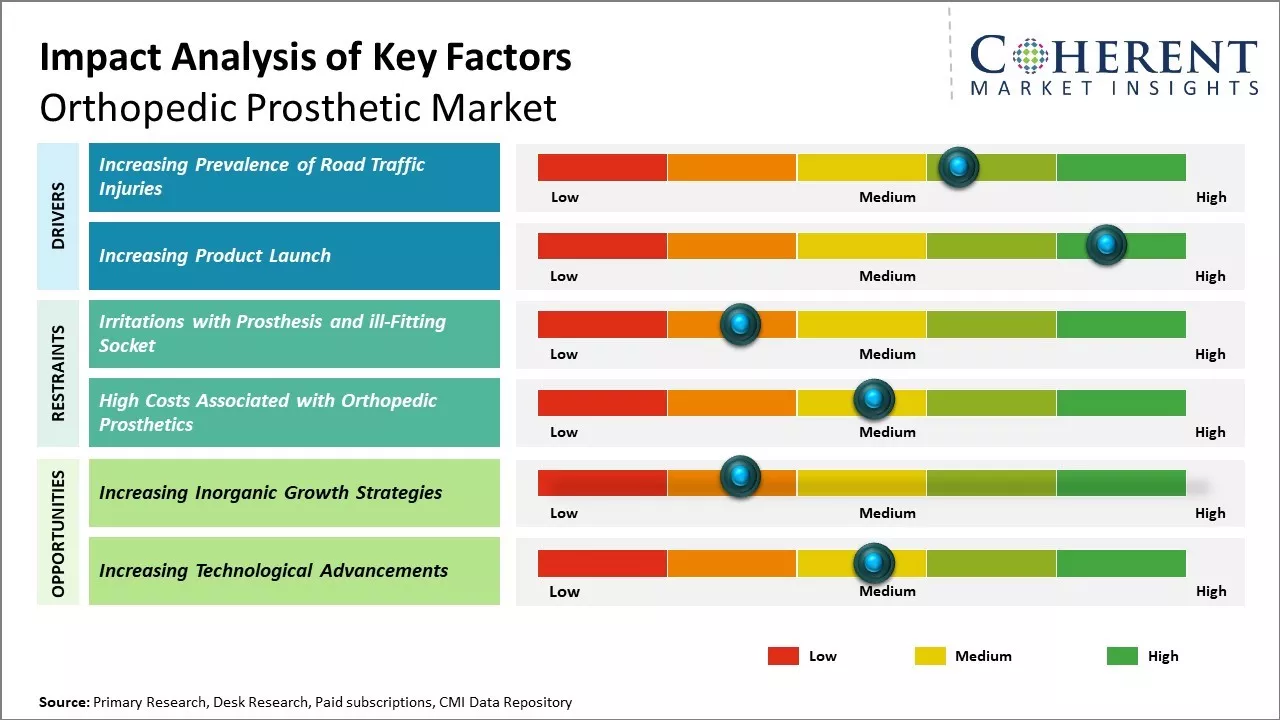
Discover market dynamics shaping the industry: Download Free Sample
The global orthopedic prosthetic market is driven by the rising geriatric population and the associated increase in the number of orthopedic diseases, tumors, or bone deformations among the elderly population. The market is also witnessing strong growth due to the increasing sports and road accident-related injuries leading to amputations. Technological advancements in 3D printing and prosthetics design have improved the cosmetic appearance and functionality of prosthetic devices. With growing awareness and availability of specialized prosthetic care, the social acceptance of those living with prosthetics is increasing globally.
Increasing Prevalence of Road Traffic Injuries
The increasing prevalence of road traffic injuries is poised to push growth in the global orthopedic prosthetic market over the coming years. According to data from the World Health Organization, road traffic crashes cause around 1.35 million deaths annually worldwide. While the highest road traffic death rates are seen in low-income countries, even developed nations are witnessing elevated injury rates. For example, reports from the Centers for Disease Control and Prevention showed over 4 million road injuries occurred in the United States in the year 2020 alone.
Increasing prevalence of road traffic injuries is expected to propel the growth of the global orthopedic prosthetic market during the forecast period. For instance, in June 2022, the World Health Organization (WHO) published a fact sheet according to which, every year around 20 to 50 million people suffer from non-fatal injuries, with many incurring a disability.
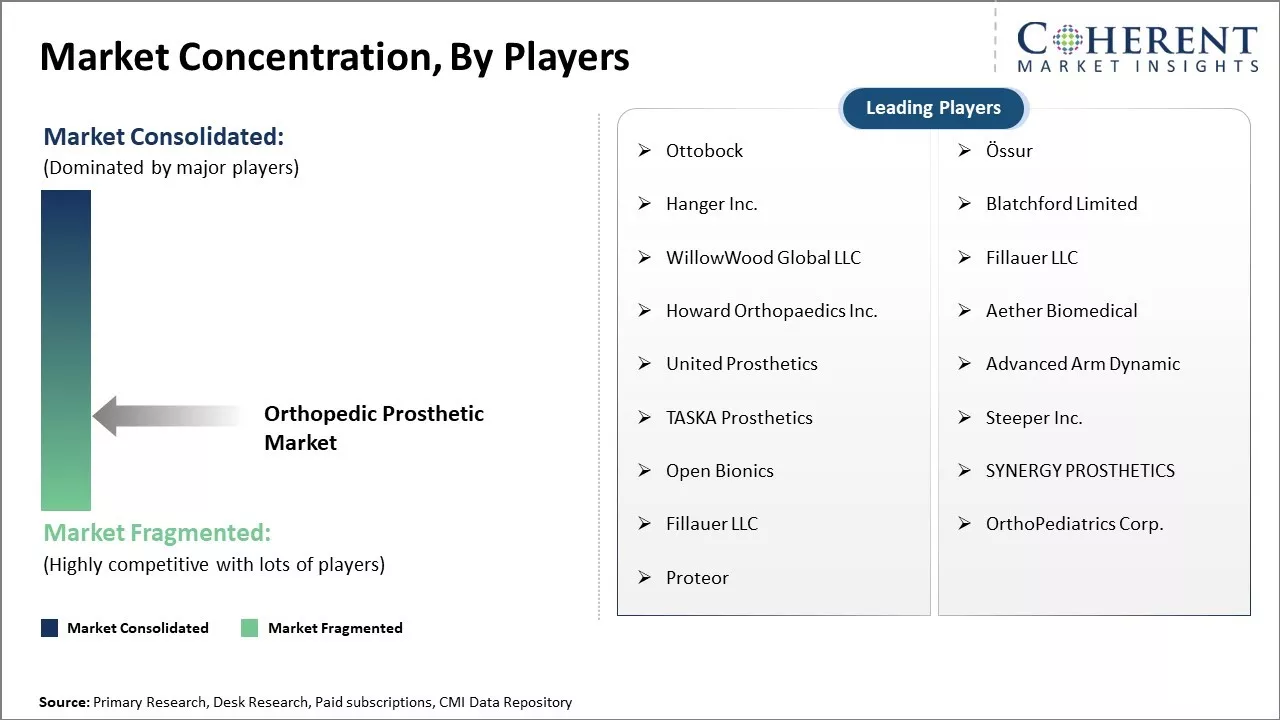
Get actionable strategies to beat competition: Download Free Sample
Increasing Product LaunchesKey companies focusing on product launches to advance the development of new technology prosthetics are expected to propel the growth of the global orthopedic prosthetic market during the forecast period. For instance, in September 2022, Ossur, one of the global leaders in the orthotics and prosthetics (O&P) industry, announced the launch of a new POWER KNEE, a bionic technology and a motor prosthesis. The power knee, uses advanced algorithms to detect motion, movement pattern, and adjust the speed of wearer. They are designed to create motion and provide active powered assistance.
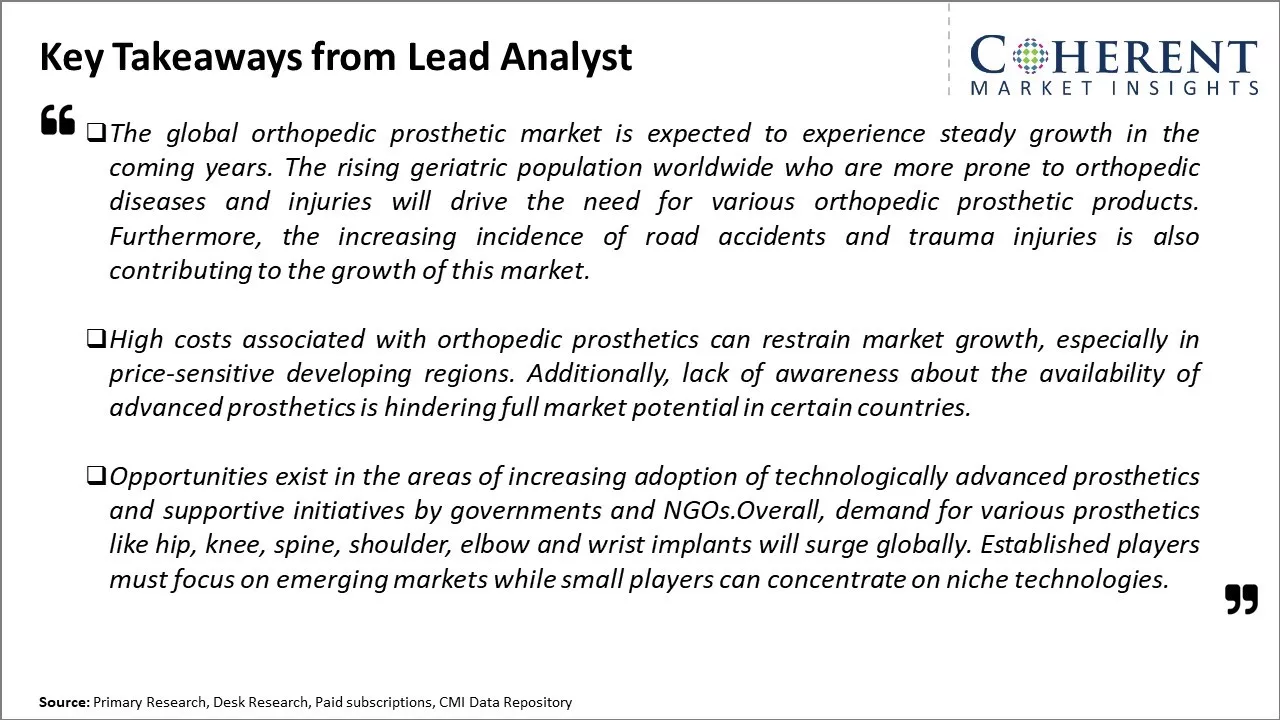
To learn more about this report, Download Free Sample
Market Challenges – Irritations with Prosthesis and ill-Fitting SocketThe major factors that hinder the global orthopedic prosthetic market growth include the irritations with prosthesis that cause frustration and ill-fitting socket. For instance, in January 2022, a paper was published by Frontiers in Rehabilitation Sciences, according to which irritation due to prosthesis is not easily solvable due to its make-up and design. As there is continual changes to the user's residual limb, the sockets present in the prosthetic are rigid in nature due to which they cannot change according to users’ limb functioning.
Market Opportunities – Increasing Inorganic Growth Strategies
Increasing adoption of inorganic growth strategies, such as collaborations, is expected to offer lucrative growth opportunities in the market. For instance, in February 2023, MIT’s K. Lisa Yang Center for Bionics entered into a collaboration with the government of Sierra Leone to strengthen the capabilities and services of that country’s orthotic and prosthetic (O&P) sector.
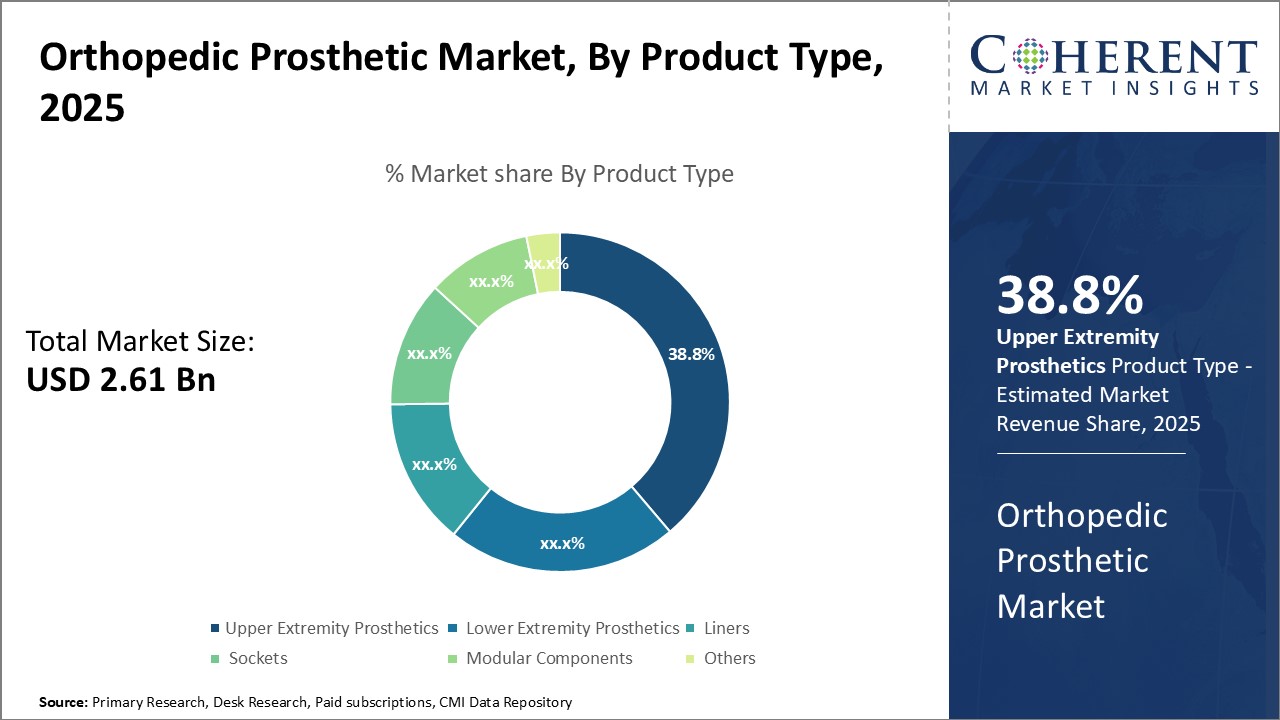
Discover high revenue pocket segments and roadmap to it: Download Free Sample
Insights, By Product Type: Higher Incidence of Arm Disabilities is Driving the Demand for Upper Extremity ProstheticsThe product type segment includes upper extremity prosthetics, lower extremity prosthetics, liners, sockets, modular components, and others. The upper extremity prosthetics sub-segment is estimated to hold 38.8% of the market share in 2025 owing to the higher incidence rate of disabilities affecting the arms and hands globally. There are several factors contributing to the growing need for upper body prosthetics. Firstly, industrial and workplace accidents are one of the leading causes of amputations and disabilities affecting the arms worldwide. With increasing industrialization and expansion of manufacturing sector in developing economies, incidents of hands and arms getting severed in machines remain elevated. Secondly, injuries from road accidents are another major driver. Along with legs, arms often bear the brunt of injuries in collisions and accidents. Since road traffic continues to surge across both developing and developed nations, trauma cases requiring upper limb prosthetics remain substantial. In addition, the rising prevalence of congenital disabilities like dysmelia (limb reduction deficiencies) leads to a steady requirement for upper extremity prosthetics. Lastly, the growing armed conflicts and extremism in certain parts of the world also contribute to amputations through bomb explosions and targeted violence, necessitating prosthetic replacements.
Insights, By Technology: Technological Advancements Propel Electric Powered
The technology segment includes conventional, electric powered, and hybrid orthopedic prosthetics. The electric powered sub-segment is estimated to hold 37.9% of the market share in 2025 due to significant technological advancements. Electric powered varieties offer more intuitive movement control through muscle signals via embedded sensors and microchips. This makes fine motor activities and prehension much more natural compared to body-powered mechanical variants. Additionally, lithium-ion batteries provide longer operation without frequent charging. Hybrid designs leverage the benefits of both myoelectric and body-powered systems through a toggle mechanism. This provides patients an option to choose between muscle-controlled precision grip or harnessing residual limb movement. Such developments have enhanced the functional capabilities and quality of life for amputees. Furthermore, ongoing research seeks to achieve even human-like capabilities through neural interfacing and mind-controlled bionics. Collectively, technological innovations are expanding the frontiers of prosthetics and positively impacting growth in the electric and hybrid segments.
Insights, By End User: Expanding Healthcare Infrastructure is Favoring the Hospitals Segment
The end user segment includes hospitals, prosthetic clinics, rehabilitation center, and others. The hospitals sub-segment is estimated to hold 34.4% of the market share in 2025 due to expanding health infrastructure in developing nations. Post-amputation, several follow-up visits and fittings are required with a prosthetist to achieve effective residual limb care, gait training and device alignment. This rehabilitation process is best supported through in-patient hospital stays assisted by qualified professionals. Additionally, major amputations often require immediate surgical attention and recovery care, establishing the hospital as the primary end user. Furthermore, favorable government policies geared towards strengthening public healthcare networks across emerging economies are positively impacting the segment growth. Large hospitals are procuring the latest prosthetic technologies to offer comprehensive rehabilitation services. The growing medical tourism sector is also contributing as people travel abroad for affordable high-quality care including prosthetics fitting and training
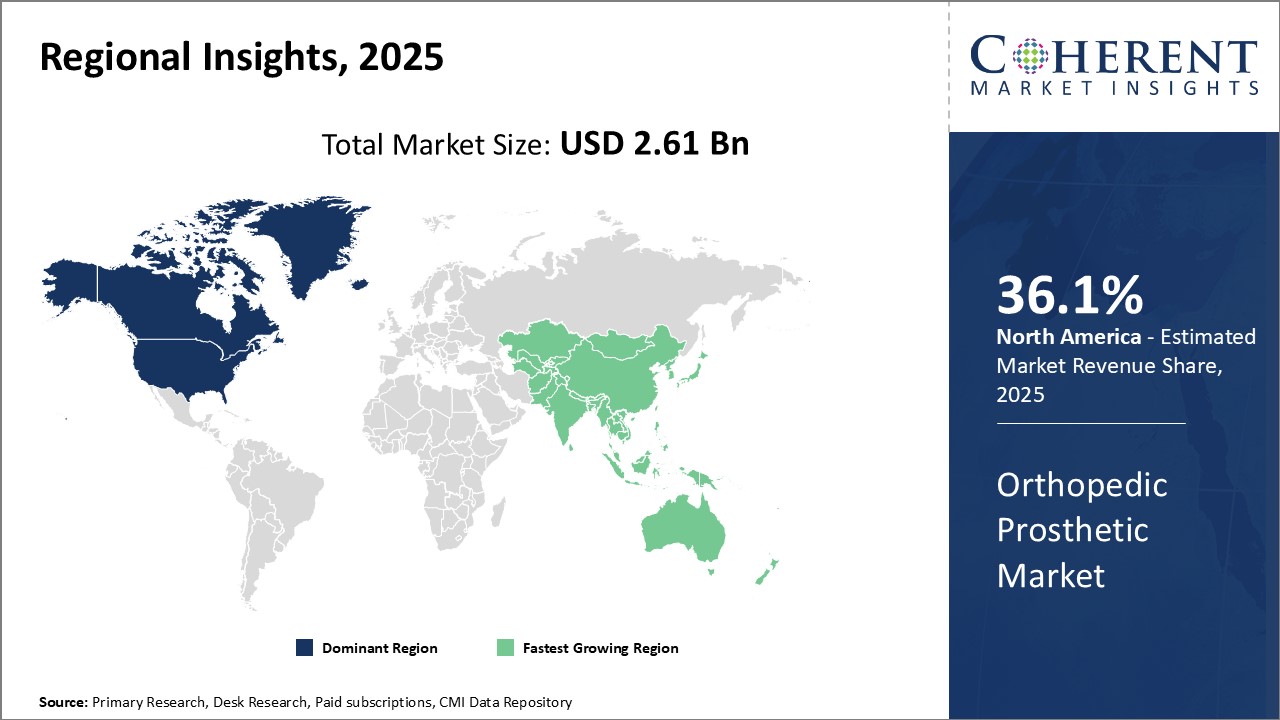
Need a Different Region or Segment? Download Free Sample
North America remains the dominant region in the global orthopedic prosthetic market and is estimated to hold 36.1% of the market share in 2025 owing to increasing product approvals by the U.S. Food and Drug Administration (FDA). For instance, in December 2022, the U.S. Food and Drug Administration approved the Osseoanchored Prostheses for the Rehabilitation of Amputees (OPRA) Implant System, the first implant system marketed in the U.S. for adults who have transfemoral or above-the-knee amputations and who have or are anticipated to have rehabilitation problems with, or cannot use, a conventional socket prosthesis.
The Asia Pacific region has emerged as the fastest growing market for orthopedic prosthetics in recent times. Factors such as the rising geriatric population, improving access to healthcare, and growing medical tourism are aiding the market growth. Countries like China, India, and Japan have witnessed substantial economic development which has enhanced the affordability of orthopedic products. This has opened up the market beyond tertiary cities to tier 2 and tier 3 areas as well. Additionally, regional players are strengthening their manufacturing capabilities to serve the large domestic demands. Some of them are also collaborating with global companies for technical know-how transfer to accelerate product development. This has added competitive pricing dynamics to the region.
Orthopedic Prosthetic Market Report Coverage
| Report Coverage | Details | ||
|---|---|---|---|
| Base Year: | 2024 | Market Size in 2025: | USD 2.61 Bn |
| Historical Data for: | 2020 To 2024 | Forecast Period: | 2025 To 2032 |
| Forecast Period 2025 to 2032 CAGR: | 5.9% | 2032 Value Projection: | USD 3.89 Bn |
| Geographies covered: |
|
||
| Segments covered: |
|
||
| Companies covered: |
Ottobock, Össur, Hanger Inc., Blatchford Limited, WillowWood Global LLC, Fillauer LLC, Howard Orthopaedics Inc., Aether Biomedical, United Prosthetics, Advanced Arm Dynamic, TASKA Prosthetics, Steeper Inc., Open Bionics, SYNERGY PROSTHETICS, Fillauer LLC, OrthoPediatrics Corp., and Proteor |
||
| Growth Drivers: |
|
||
| Restraints & Challenges: |
|
||
Uncover macros and micros vetted on 75+ parameters: Get instant access to report
*Definition: An orthopedic prosthetic is an artificial limb designed to substitute a missing body part of a patient. Artificial limbs make it possible for persons who have lost limb/limbs to functions efficiently and these prosthetics resemble original or natural limbs to a considerable extent and are users almost always pass unnoticed. There are mainly two types of limb prosthetics available, upper limb prosthetics and lower limb prosthetics. Prostheses (artificial legs and hands) enables people with physical impairments to live normal, healthy and independent life and the use of prosthetics can reduce the need of support services and caregivers to the physically impaired person.
Share
Share
About Author
Manisha Vibhute is a consultant with over 5 years of experience in market research and consulting. With a strong understanding of market dynamics, Manisha assists clients in developing effective market access strategies. She helps medical device companies navigate pricing, reimbursement, and regulatory pathways to ensure successful product launches.
Missing comfort of reading report in your local language? Find your preferred language :
Transform your Strategy with Exclusive Trending Reports :
Frequently Asked Questions
Joining thousands of companies around the world committed to making the Excellent Business Solutions.
View All Our Clients